Interference-Free Semiquantitative Analysis
Special Issues
Semiquantitative elemental analysis by ICP-MS is a powerful tool for quick screening of unknown samples for a wide range of elements.
Recent advances in collision–reaction cell technology have all but eliminated interferences from quantitative inductively coupled plasma mass spectrometry (ICP–MS) for most matrix types. However, in general, this technology requires specific information about the matrix and target analytes to set up the correct collision–reaction chemistry to eliminate the interferences. Additionally, the conditions required to eliminate one interference in one matrix frequently are not effective for all analytes in all matrices. For this reason, multiple sets of collision–reaction conditions typically are used. This results in significant deviations from predicted relative response factors for elements acquired under varying conditions. Making useful semiquantitative measurements requires that all elements be acquired under the same conditions. As a result, it has not been possible to use collision–reaction cell technology to reduce interferences in semiquantitative analysis in the same way as in full quantification. However, polyatomic interferences can be eliminated using carefully controlled kinetic energy discrimination (KED) in helium collision mode (Agilent 7500ce Octopole Reaction System), which can allow good semiquantification in most matrices for most analyte isotopes. Because helium is a nonreactive gas, no new interferences are formed in the cell, and plasma-formed polyatomic interferences are eliminated generically as a function of their larger ionic radii (Figure 1).

Figure 1
When only a single set of collision–reaction cell conditions is used, accurate relative response factors are maintained. Because helium collision mode eliminates only polyatomic interferences, interference-free isotopes of elements suffering from isobaric interferences still must be used. For the most part, the only significantly affected isotope is 40Ca. In this case, 44Ca can be used. KED eliminates the transmission of the larger polyatomic ions to the quadrupole by placing an energy barrier between the octopole and quadrupole (Figure 2).
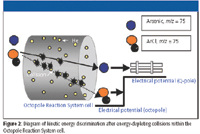
Figure 2
Because the larger polyatomic ions undergo more energy-depleting collisions with He in the cell than do the smaller atomic ions, they lack sufficient energy to cross the barrier. Figure 3 depicts the effects of KED on ion energy. Only the high-energy atomic ions exceed the stopping potential and are transmitted.

Figure 3
Figures 4–7 illustrate the effective removal of multiple polyatomic interferences on several interference-prone elements. In this case, a standard containing 5 ppb of the elements of interest was measured in a matrix containing increasing concentrations of sulfuric acid, hydrochloric acid, and butanol.
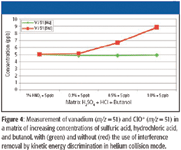
Figure 4
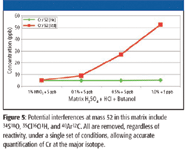
Figure 5
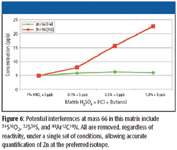
Figure 6
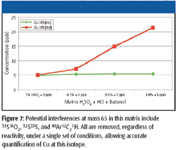
Figure 7
This matrix was designed to create sulfur-, carbon-, chlorine-, and oxygen-based interferences. Measurements were taken in the "normal" mode (no gas in the collision cell) and in helium collision mode. Instrument conditions are listed in Table I.

Table I: Instrument conditions used for acquisitions depicted in Figures 4â7
Semiquantitative Method
The instrument was tuned for typical robust plasma conditions, which are essentially the same as the default parameters. Helium collision mode was tuned for reasonable transmission of low mass ions (helium flow = 3–4 mL/min and QP focus = –10 V) and efficient energy discrimination of polyatomic species (3 V gradient between octopole bias and quadrupole bias). Under these conditions, matrix effects such as ionization suppression and the formation of interferences in the plasma are minimized. Extract 1 is set at 0 V to maximize the system stability and ensure the narrowest possible ion energy distribution. Low ion energy distribution is essential to efficient energy discrimination (Figure 3). The following acquisition parameters were used (Figure 8):
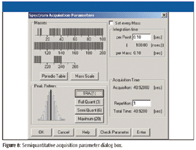
Figure 8
Integration time: .........0.1 s
Mass range: ..............5–240
Replicates .................1
Peak pattern ..............Peak hopping, single slice per mass
The "empty masses" — for example, between 210 and 230 — and masses for elements including C, O, N, F, and the noble gases were skipped to reduce total acquisition time. Total acquisition time is less than 60 s for one replicate. Additional slices per mass can be acquired if desired, but at increased total acquisition time. A single slice is sufficient for semiquantitative screening mode.
A single calibration standard at 100 ppb, made up in 1% nitric acid– 0.5% hydrochloric acid, was used to update the semiquantitative response factor database for a range of elements across the mass range. Noncalibrated elements are updated by interpolating between calibrated isotopes, which the software does automatically. Any number of calibration elements can be used, but increasing the number of calibration elements will improve semiquantitative accuracy. Internal standardization was applied using a typical suite of internal standard elements distributed across the mass range.
Results
Tables II and III show the results of a semiquantitative screen of two standard reference materials, NIST 1640 water and LGC 6177 landfill leachate. No attempt was made to matrix-match, and a single generic set of plasma conditions was used with the helium collision mode only. In all cases, for every certified element, the measured response was very close to the certified concentration from as low as 2 ppb for Rb in NIST 1640 to over 1700 ppm for Na in the LGC 6177 landfill leachate.

Table II: Results of semiquantitative analysis of NIST 1640 standard reference water using He semiquantitative mode (ppb)
Conclusions
Semiquantitative analysis has always been a powerful tool available to ICP-MS analysts for quickly estimating the concentration of unknown, uncalibrated elements in a variety of simple matrices. However, in complex matrices, polyatomic interferences could render the results for many elements useless. Collision–reaction cell technology, which requires more than one set of conditions for all masses, cannot be used because it would result in deviation from the standard relative response tables upon which semiquantitative analysis is based. Helium collision mode coupled with kinetic energy discrimination can overcome these limitations. By effectively removing polyatomic interferences, rapid semiquantitative screening of a wide range of sample types for most analyte elements is possible.
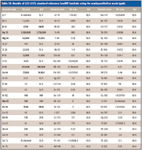
Table III: Results of LGC 6177, standard reference landfill leachate using He semiquantitative mode (ppb)
Glenn Woods is ICP-MS Applications Engineer, and Ed McCurdy is ICP-MS Product Specialist, with Agilent Technologies, Manchester, UK.
Steven Wilbur is Applications Chemist with Agilent Technologies, Lopez Island, Washington.
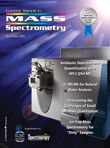
A Guide to (U)HPLC Column Selection for Protein Analysis
April 16th 2025Analytical scientists are faced with the task of finding the right column from an almost unmanageable range of products. This paper focuses on columns that enable protein analysis under native conditions through size exclusion, hydrophobic interaction, and ion exchange chromatography. It will highlight the different column characteristics—pore size, particle size, base matrices, column dimensions, ligands—and which questions will help decide which columns to use.
The Benefits of Custom Bonded Silica
April 1st 2025Not all chromatography resins are created equal. Off-the-shelf chromatography resins might not always meet the rigorous purification requirements of biopharmaceutical manufacturing. Custom bonded silica from Grace can address a wide range of separation challenges, leading to real performance improvements. Discover more about the latest innovations in chromatography silica from Grace, including VYDAC® and DAVISIL®.
5 Things to Consider When Selecting a Chromatography Silica
April 1st 2025Particularly in the pharmaceutical industry, drug purity isn’t just a goal – it’s essential for achieving safety, stability and efficacy. However, purification is easier said than done, especially with challenging molecules like DNA and RNA “oligonucleotides,” due in large part to their diversity and the range of impurities that can be generated during production. Enter DAVISIL® chromatographic silica, with a wide range of pore diameters and particle sizes to meet your specific application, performance and sustainability requirements. Before you choose the chromatography resin for your next purification application, take a look at these 5 considerations.
Automating Protein Purification: Efficiency, Yield, and Reproducibility
March 27th 2025Recent advancements in automated protein purification stress the importance of efficiency, scalability, and yield consistency. This eBook compares different purification platforms, highlighting their impact on downstream applications and demonstrating how automation enhances throughput and process control.







